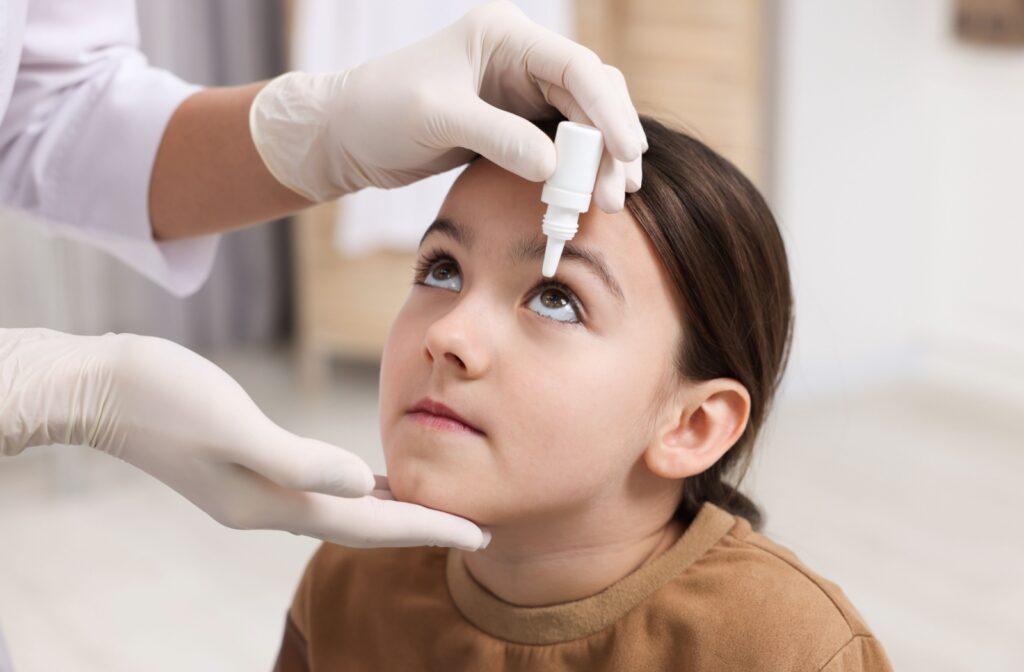For many children, allergies can flare up during seasonal changes or as a result of exposure to triggers such as pollen, pet dander, or dust. Eye drops can be an effective, fast-acting solution to allergies, but it’s best to use antihistamine or lubricating eye drops over steroid eye drops, which are less safe for children.
Your optometrist can recommend eye drop brands that best suit your child’s needs and supervise if their allergies are severe enough for more potent eye drops.
When Are Eye Drops the Best Solution for Allergies?
Eye drops can often relieve the discomfort caused by allergies, but they’re not always the first line of treatment. If your child’s allergy symptoms primarily include watery, itchy, or red eyes and over-the-counter oral antihistamines aren’t providing sufficient relief, eye drops may be worth considering.
However, consider consulting a pediatrician or eye specialist before beginning any course of treatment. Severe reactions, ongoing irritation, or additional symptoms such as pain or blurred vision could signal an underlying condition that requires further medical attention.
Types of Eye Drops Safe for Children
Not all eye drops are created equal when treating kids’ allergies. Here are the most common types and what they treat best.
- Antihistamine Eye Drops: Perfect for fast relief, these eye drops block histamines to reduce itchiness almost instantly. Brands like Zaditor and Alaway are popular options often recommended for children. They’re safe for children over 3 years old and typically require only one or two daily applications.
- Lubricating Eye Drops (Artificial Tears): Lubricating eye drops can provide soothing relief for mild allergies or general dryness. These drops wash allergens out of the eyes and help maintain natural moisture. Look for preservative-free brands, which tend to be gentler on sensitive eyes.
- Decongestant Eye Drops: Decongestant eye drops reduce redness by shrinking blood vessels. However, they’re not recommended for long-term use, as they can lead to rebound redness. Use them cautiously and consult a healthcare provider before administering them to children.
- Combination Drops: Some eye drops, like Pataday, combine antihistamines and mast-cell stabilizers for immediate symptom relief and long-term benefits. These are especially helpful during peak allergy seasons.
The Best Kid-Safe Eye Drops for Allergies
Based on safety, effectiveness, and ease of use, here are some of the best eye drops for children with allergies.
- Zaditor Antihistamine Eye Drops
- Safe for children ages three and up
- Provides 12-hour relief from itchiness
- Does not contain vasoconstrictors (which can cause rebound redness)
- Systane Ultra Lubricant Eye Drops (vasoconstrictor)
- Great for relieving dryness and washing away allergens
- Gentle, preservative-free option for kids with sensitive eyes
- Pataday Once Daily Relief
- Suitable for children over 2 years old
- Offers long-lasting benefits with just one application per day
- Combines antihistamines with lasting protection
What Else Can Kids Use Eye Drops For?
Eye drops aren’t only for allergies. Your child’s optometrist may recommend them for other conditions, such as:
- Dry Eye: Artificial tears can help if screen time or dry air causes discomfort.
- Minor Eye Irritations: Lubricating drops can wash out debris or soothe irritation caused by wind or chlorine from swimming pools.
- Conjunctivitis (Pink Eye): Depending on the cause, prescription drops may help treat bacterial or allergic conjunctivitis.
Eye Drops to Avoid Giving Children
Not all eye drops are suitable for young users. Be cautious of the followings kinds of drops:
- Steroid Eye Drops: While sometimes prescribed in severe cases, steroid-based eye drops should only be used under close supervision from a pediatrician or eye specialist. Misuse can lead to increased eye pressure or other side effects.
- Decongestant-Only Drops: Although effective at reducing redness, these drops can lead to dependency and may worsen symptoms over time.
- Adult-Specific Products: Some over-the-counter eye drops are designed for adult use only. To ensure safety, always check the age recommendations and ingredient list.
How to Administer Eye Drops to Kids

Administering eye drops to children often feels challenging, but it doesn’t have to be stressful.
- Explain the Process: Explain what to expect and reassure your child that it will only take a few seconds and will help their eyes feel better.
- Use the “Tilt Back” Method: Have your child lie on their back with their neck slightly tilted. If they refuse, try applying drops while they’re sitting by gently leaning their head back.
- Create a Drop Pocket: Pull down the lower eyelid to create a small pocket for the drop.
- Distract Your Child: During the process, focus your child’s attention on a toy, story, or video. Some parents find turning the process into a game to be helpful.
- Reward Them Afterwards: A small treat or praise can make them associate the routine with something positive.
Other Ways to Relieve Eye Allergy Symptoms in Kids
Eye drops are beneficial, but combining them with other allergy-relief strategies can enhance your child’s comfort–especially if it is challenging for them to use eye drops. These include:
- Keep Allergens Away: Limit time spent outdoors during high-pollen seasons. Use an air purifier indoors and keep windows shut.
- Cold Compress: Placing a clean washcloth over your child’s eyes can reduce swelling and relieve itchiness.
- Eye Hygiene: Clean your child’s eyelids with a wet cotton ball to remove allergens.
- Over-the-Counter Antihistamines: Oral antihistamines can work alongside eye drops to combat broader allergy symptoms.
Take Action for Allergy Relief
Finding the best eye drops for kids with allergies doesn’t have to be overwhelming. Knowing what to look for and following the recommended guidelines can help your child find relief quickly and safely.
Insight Vision Care knows it can be stressful to help young children when they’re irritated or in pain because of allergies. Contact us today for tailored advice on eye drops and other solutions to your child’s eye symptoms from allergies.



